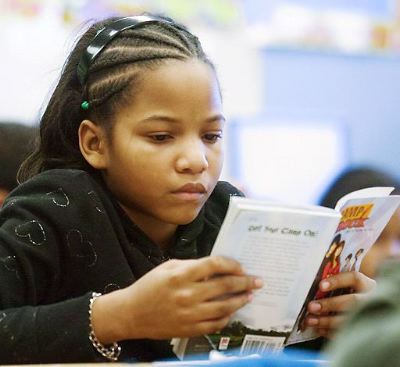Phonological Awareness |
Note: According to the International Reading Association, "...phonemic awareness is highly predictive of success in learning to read - in particular in predicting success in learning to decode. In fact, phonemic awareness abilities in kindergarten (or in that age range) appear to be the best single predictor of successful reading acquisition." (IRA, 1998) Important Terms This list reflects an increasing level of difficulty in phonological tasks and represents the approximate order that students develop specific phonological skills (sometimes referred to the hierarchy of literacy skills development). RHYME - the correspondence of ending sounds of words or lines of verse. Rhyming is the ability to identify words that have identical final sound segments. WORD AWARENESS - refers to the knowledge that sentences consist of words and that these words can be manipulated SYLLABLE AWARENESS - the ability to hear parts or segments of phonemes that comprise the rhythm of the word PHONEMIC AWARENESS - the ability to attend to, identify, and manipulate the sounds that are representative of graphemes (letters) in the English language. PHONETIC AWARENESS - understanding the relationships between sounds and their symbols (letters), and the methods of instruction used to teach those relationships. |
|
Some of these children have not had the experiences described above and others may have some underlying disability that inhibits the development of phonemic awareness. Many speculate that this disability may be at the root of dyslexia. What to Look For: What teachers should watch for are problems hearing the difference between sounds more than the child’s ability to accurately say them. Watch for signs that a child does not notice when you change words, or deliberately mispronounce words in a familiar story or song (for example, reading “wittle wed widing hood” - that may be how a child says it, but they should be able to tell you when you are reading it to them incorrectly. (Marks, www.illinoisearlylearning.org). What to Do: Many activities already used by preschool and primary teachers can be used to attend to those with a difference in their ability to distinguish sounds in oral language. In general, cultivating an environment that encourages play with spoken language. Rhymes, riddles, songs, poems, and read-aloud books that manipulate sounds may be used to draw students’ attention to the sounds of spoken language. (IRA 1998) Specifically, if a child is having trouble identifying sounds in a word, it can be helpful to start with larger chunks. Start with asking the child to repeat after you. Tell her a compound word “cupcake” and ask the child to repeat it, then ask the child to say “cupcake” without the “cup”, help the child say “cake”. Next, move to syllables. Say “window”. Now say “window” without the “win”. Eventually you can do this with beginning and ending sounds (onset and rimes). For example: “Say ‘pig’. Now, say ‘pig’ with out the ‘puh’ sound.” (Marks, illinoisearlylearning.org). |
For younger students: It is important to remember that younger English language learners may be in the midst of developing phonological awareness in their native language. Difficulties can arise when sounds are used in one language but not in another. Teacher should make sure to speak slowly with clear articulation so that students can hear and replicate the basic phonemes of English; and to distinguish between the sounds of the English language and their native language. For older students: ESL teacher Anthony Terrell states that “Phonemic awareness seems to unlock the substantial passive English vocabulary older ESL learners bring with them, but are unable to access or decode from written text. This anecdote from his classroom best illustrates this phenomenon: “Students often had much to say, had enough passive vocabulary to say it, but lacked the ability to use that passive vocabulary to effectively put their thoughts onto paper. The perennial question in the room became, “How do you spell…how do you spell….Mister, Mister, how do you spell?” My natural response to the numerous spelling inquires was a good old-fashioned, “I am not going to tell you. Get the dictionary.” I soon realized that instead of having the intended effect of helping students build both vocabulary and a sense of academic self-reliance, my response often caused even more frustration and withdrawal from students. Why? Quite simply, students often had little idea where to even begin to look in a dictionary for the word they were trying to spelling. The sounds of the words students knew they wanted to use had no connection to the symbols that represent those sounds in the English language. My students had little-to-no phonemic awareness. What impact was this having on their ability to express” themselves in writing? Additionally, was this why I was hearing them stumble over words in print that I was sure I had heard them use?” Terrell says that older ELL students need explicit phonemic awareness instructions as part of a balanced literacy curriculum. Many strategies, games etc. are designed for younger students. Teachers will need to adapt those models for older students. |
A study in the late 1980s parents of precocious readers reported that their children could recite the alphabet and identify capital letters before the age of 3. Many began reading preprimer books by age 4 and sounded out unfamiliar words by age five. (Suzby, 1985 as cited in Robinson et.al.). In a publication entitled What Works published by the U.S. Department of Education in 1987, parents were told that the best way to help their children become successful readers was to read to them. In fact, a study shows that children who learn to read before entering school often teach themselves to read through storybook reading. Precocious readers are more likely to diverge in their progress through the hierarchy of reading development skills (see Important Terms) than their typical peers. And, according to Sacks and Mergendoller (1997) as cited in Robinson et. al, ... different methods of instruction may produce different outcomes, depending on the student’s stage of reading development...” In the same article Burns et.al (1991) is cited for finding “...that when early readers are not challenged, their achievement scores regress; that is, without instruction on their level, their scores drop toward those of more average readers. What to do: Teachers need to provide different kinds of support for children at different stages of development to maximize progress; higher scoring students need access to higher stage literacy tasks and material. |
|



